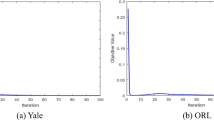Abstract
An asymmetry algorithm recognition model, which is presented based on Hessian matrix transform by adjusting the diagonal parameter of Hessian matrix and which does not change the positive semi-definite characteristic, increases or decreases the distance between positive class or negative class and hyperplane on the asymmetry sample set and realizes our intention for separating the small samples more precisely. The experiment indicates that we cannot simply fix the diagonal parameter of Hessian matrix but must dynamically adjust the diagonal weight coefficient for controlling the number of error-divided samples. This modified asymmetry learning algorithm is more superior than the traditional standard SVM method and can recognize DNA sequence and its mean recognition rate comes to 93.3%.




Similar content being viewed by others
References
Anfinsen CB, Haber E, Sfla M, White FH Jr (1961) The kinetics of formation of native ribonuclease during oxidation of the reduced polypeptide chain. Proc Natl Acad Sci 47(9):1309–1314
Attwood TK, Parry-Smith DJ (2002) Introduction to bioinformatics (trans: Luo JC). Peking University Press, Beijing
Chautard E, Ballut L, Thierry-Mieg N, Ricard-Blum S, Matrix DB (2009) A database focused on extracellular protein-protein and protein-carbohydrate interactions. Bioinformatics 25(5):690–691
Blankenburg H et al (2009) Exchanging, annotating and assessing molecular interaction data. Bioinformatics 25(10):1321–1328
Kandasamy K et al (2009) PathBuilder–open source software for annotating and developing pathway resources. Bioinformatics 25(21):2860–2862
Cain SA et al (2009) Defining elastic fiber interactions by molecular fishing: an affinity purification and mass spectrometry approach. Mol Cell Proteomics 8(12):2715–2732
Keerthikumar S et al (2009) Prediction of candidate primary immunodeficiency disease genes using a support vector machine learning approach. DNA Res 16(6):345–351
Zhao J, Jiang P, Zhang W (2010) Molecular networks for the study of TCM pharmacology. Brief Bioinform 11(4):417–430
Wang L et al (2010) An integrated database of human lung cancer research. Nucleic Acids Res 38(suppl_1):D665–D669
Zheng P et al (2010) Ye predicting meiotic pathways in human fetal oogenesis. Biol Reprod 82(3): 543–551
Wu CC et al (2010) Prediction of human functional genetic networks from heterogeneous data using RVM-based ensemble learning. Bioinformatics 26(6):807–813
Boser BE, Guyon IM, Vapnik VN (1992) A training algorithm for optimal margin classifiers. In: Haussler D (ed) Proceedings of the 5th annual ACM workshop on computational learning theory. ACM Press, Pittsburgh, PA, pp 144–152
Vapnik VN (1998) Statistical learning theory. Wiley, New York
Mika S et al (1999) Fisher discriminant analysis with Kernels. Neural networks for signal processing IX. IEEE Press, New York, NY, pp 41–48
Suykens JAK et al (2002) A support vector machine formulation to PCA analysis and its Kernel version. ESAT-SCD-SISTA technical report 2002-68, Katholieke Universiteit Leuven, Belgium
Seeger M (2004) Gaussian processes for machine learning. Int J Neural Syst 14(2):1–38
Hui HZ, Ze CY, Gui LY, Ming XX (2005) Data fusion for fault diagnosis using multi-class support vector machines. J Zhejiang Univ Sci 6A(No. 10):1030–1039
Hofmann T, Schölkopf B, Smola AJ (2008) Kernel methods in machine learning. Ann Stat 36:1171–1220
Taylor JS, Cristianini N (1999) Further results on the margin distribution. In: Proceedings of the 12th conference on computational learning theory, pp 278–285
Karakoulas GJ, Taylor JS (1999) Optimizing classifiers for imbalanced training sets. In: NIPS, pp 253–259
Cristianini N, Shawe-Taylor (2005) Introduction to support vector machines, (trans: Li G-z, Wang-meng, Zeng H-J). Electronic Industry Press, Beijing
Xue Y (2001) Optimization theory and methods. Beijing Industrial University Press, Beijing
Murzin GA et al (2010) Structural classification of proteins. http://scop.mrc-lmb.cam.ac.uk/scop/
Hyvärinen A (1999) Fast and robust fixed-point algorithms for independent component analysis. IEEE Trans Neural Netw 10(3):626–634
Potamitis L, Fakotakis N, Kokkinakis G (2000) Independent component analysis applied to feature extraction for robust automatic speech recognition. Electron Lett 36:23
Jung TP et al (2001) Imaging brain dynamics using independent component analysis. Proc IEEE 89(7):1107–1122
Zhang XH, Chen CH (2002) New independent component analysis method using higher order statistics with application to remote sensing images. Opt Eng 41(7):1717
Choudrey RA, Roberts SJ (2003) Variational mixture of Bayesian independent component analyzers. Neural Comput 15(1):213–252
Boscolo R, Pan H, Roychowdhury VP (2004) Independent component analysis based on nonparametric density estimation. IEEE Trans Neural Netw 15(1): 55–65
Lu W, Rajapakse JC (2005).Approach and applications of constrained ICA. IEEE Trans Neural Netw 16(1): 203–212
Gao P, Woo WL, Dlay SS (2006) Non-linear independent component analysis using series reversion and Weierstrass network. IEEE Proc Vision Image Signal Process 15(2): 115
Hamza A, Chitroub S (2007) Performance study of receiver based on independent component analysis in CDMA systems. Automat Contr Comput Sci 41:6, 343–349
Crespo-Garcia M, Atienza M, Jose LC (2008) Muscle artifact removal from human sleep EEG by using independent component analysis. Ann Biomed Eng 36(3):467–475
Xu L et al (2009) Source-based morphometry: the use of independent component analysis to identify gray matter differences with application to schizophrenia. Hum Brain Mapp 30(3):711–724
Zhang L et al (2010) Improving mental task classification by adding high frequency band information. J Med Syst 34(1):51–60
Acknowledgments
The work is supported by Natural Science Foundation Project of CQ CSTC and Science & Technology Program of ChongQing NanAn.
Author information
Authors and Affiliations
Corresponding author
Rights and permissions
About this article
Cite this article
Luo, Z., Song, L. An asymmetry algorithm based on parameter transformation for Hessian matrix. Neural Comput & Applic 21, 1545–1550 (2012). https://doi.org/10.1007/s00521-012-0876-7
Received:
Accepted:
Published:
Issue Date:
DOI: https://doi.org/10.1007/s00521-012-0876-7




